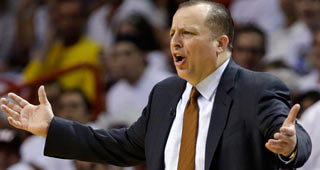The 2016-17 Minnesota Timberwolves are like Martin Scorsese in 1973, or Julia Louis-Dreyfus in 1992, once-in-a-generation talents who are perched on the edge of sustainable greatness.
Twenty-year-old Karl-Anthony Towns is a category 11 tidal wave, while 21-year-old Andrew Wiggins is the prodigious wing whose lower body resembles a pirouetting hoverboard crossed with 1000 pogo sticks.
The NBA guarantees nothing, and great expectations usually transform into a ticking time bomb if they’re unmet before too long. But beyond the multiple All-Star games, MVP trophies and Hall of Fame plaques Towns and Wiggins may experience, the unknown variable that may hold Minnesota back is simultaneously the primary reason so many believe this team will make a humongous leap forward: Tom Thibodeau.
This offseason, the former Chicago Bulls head coach replaced Sam Mitchell in that same role with the Timberwolves. But to lure him in, Minnesota also made Thibodeau its president of basketball operations. The man clearly knows basketball—he’ll undoubtedly boost Minnesota from last year’s 27th-ranked defensive rating—but took this job with zero minutes of front office experience under his belt. Even though Scott Layden—an experienced albeit imperfect hand who spent the past four years as an assistant general manager for the San Antonio Spurs—is by his side, it’s safe to presume Thibodeau has final say on every personnel decision that matters.
But even though he inherited a team that hadn’t made the playoffs in 13 years and only won 29 games last season, Thibodeau isn’t drunk on power. He quietly upgraded his new bench and refused to trade young assets for win-now stars (namely Jimmy Butler). He flashed restraint and foresight.
Let’s start with a look at Minnesota’s revamped reserves. According to NBAWowy, last season the Timberwolves were outscored by about 10 points per 100 possessions in 800 minutes when Towns, Wiggins and Ricky Rubio weren’t on the floor. They entered the offseason with a major need for outside shooting, interior defense and, just, competent play off the pine.
As a response, they replaced Kevin Garnett and Tayshaun Prince (who’re a combined 76 years old) with Cole Aldrich and Brandon Rush. Last season, Zach LaVine spent far too much time out of position as a backup point guard, fracturing the second unit and temporarily stunting his own development. This season, they’ll have the 2016 draft’s fifth overall pick, Kris Dunn and Tyus Jones (the reigning Las Vegas Summer League MVP!) at the helm.
Their biggest addition (no pun intended) was Aldrich, who signed an incredibly team-friendly three-year, $22 million deal that decreases annually and is partially guaranteed in 2019. Last year, his first with the Los Angeles Clippers (under Thibodeau’s good friend Doc Rivers), the six-year veteran finished second among centers in Defensive Real Plus-Minus (fourth among all positions), and 21st overall.
Aldrich led the league in contest percentage, per Nylon Calculus, and held opponents to an impressive 48.9 percent at the rim when he was the closest defender. This doesn’t mean he’s ready to step up and become a full-time starter, but with Towns and Gorgui Dieng already in town, that’s not what Minnesota needed.
Aldrich is an intimidating interior presence with underrated athleticism and effective touch around the basket. Coming off a career year, in which his PER, True Shooting percentage, and usage rate were never better, the 27-year-old could be the best backup center in the league this season.
Last season, only four teams allowed more shots at the rim than Minnesota. To boot, four teams allowed a higher percentage. It’s impossible to have routine success in the NBA while repeatedly surrendering the game’s most desirable shot, and nobody knows this more than Thibodeau. Aldrich will help.
On the wing, Minnesota quietly brought in the 31-year-old Rush, who won a championship two years ago and quietly made 41.4 percent of his threes in over 1000 minutes for the 73-win Golden State Warriors last season. Rush’s health has been up and down over the past few years, but he’s a steal at $3.5 million on a one-year deal.
Last season, the only team to utilize the three-point line less than Minnesota were the Milwaukee Bucks. Aside from LaVine, Towns and Nemanja Bjelica, nobody on the roster found success from deep. Rush won’t cure everything, but his skill-set is a perfect fit.
Over half of all Rush’s shots last year were catch-and-shoot behind the arc. He knocked down 45.5 percent of his threes above the break. Meanwhile, only the Los Angeles Lakers and Miami Heat were less accurate from that spot than Minnesota’s 32.8 percent last season. It’s a necessary albeit subtle upgrade to a team that sorely needs a reliable marksman to space the floor for Towns, Wiggins, LaVine and Rubio.
The moves Thibodeau made/approved in his first summer on the job were exactly what this organization needed, but there are still a few important questions ahead. Can Rubio and Dunn co-exist in the backcourt, or will one get traded before the year is through? Will Minnesota extend Dieng, or let him enter restricted free agency? What happens if LaVine continues to be the worst defender at his position?
For some, Thibodeau’s lacking front office experience is a reasonable concern. Full autonomy rarely results in success, and it’ll be hard for the coach-side of his brain not to influence the other half. But if Thibodeau’s (and Layden’s) first offseason is any indication of how he’ll behave over the next few years—tempered, shrewd and logical—the Timberwolves will eventually do what everyone expects: Devour.



